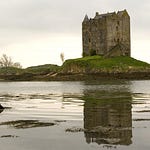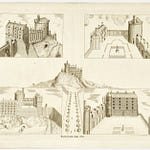Welcome back to "A Scottish Castle, A Day," brought to you by bagtownclans.com. I’m your host, Colin MacDonald, and today we’re delving into one of the most iconic castles in all of Scotland—Eilean Donan. Nestled on a rocky promontory where three sea lochs—Loch Duich, Loch Long, and Loch Alsh—meet, this stunning stronghold has captured imaginations for centuries. Eilean Donan is more than just a picture-perfect location; it’s a castle steeped in history, legend, and the dramatic power struggles of the Highlands. So let’s set the stage and step back in time to uncover the stories behind this legendary fortress.
The island where Eilean Donan Castle now stands has a rich history that stretches back long before the first stone was laid. Evidence of an ancient Pictish fort was discovered during excavations, hinting at the strategic importance of this location as far back as the Iron Age. Around 600 AD, the island became the home of St. Donan, a religious hermit who sought solitude among the rugged landscape. It’s from him that Eilean Donan—meaning "Island of Donan"—takes its name.
The first fortified castle on the island was built during the reign of Alexander II, sometime between 1214 and 1250. This was a period of significant change for Scotland, as the kingdom was solidifying its territories and defending against Norse incursions from the west. In fact, Eilean Donan’s early role was as a defensive outpost against Viking raids, a threat that loomed large over the Scottish isles during the medieval period. The curtain wall, constructed in the 13th century, enclosed most of the island and created a formidable defense.
Eilean Donan’s fortunes shifted in 1263 after the Battle of Largs, when Alexander III defeated the forces of the Norwegian king, Hákon IV. As a reward for his services in this critical battle, the castle was granted to Colin Fitzgerald, son of the Earl of Desmond and Kildare. Colin’s descendants would eventually form Clan MacKenzie, and Eilean Donan would become their most prized stronghold for centuries.
One of the most famous legends surrounding the castle involves none other than Robert the Bruce. In the early 14th century, when Bruce was fleeing from English forces, it is said that he found refuge at Eilean Donan, sheltered by John MacKenzie, the second of Kintail. This act of loyalty would later be repaid when Bruce became king, further solidifying the bond between the crown and Clan MacKenzie.
By the 16th century, the MacRaes had risen to prominence as the loyal bodyguards of the MacKenzie chiefs, earning the nickname "MacKenzie’s Coat of Mail." In 1509, they became the castle’s constables, cementing their place in the history of Eilean Donan. As political turmoil gripped the Highlands, the MacRaes played a critical role in defending the castle and the surrounding lands.
Eilean Donan, however, was not immune to the sweeping forces of history. The castle became embroiled in the Jacobite uprisings of the 18th century, which sought to restore the exiled Stuart monarchy to the thrones of England, Scotland, and Ireland. In 1719, during the brief but significant Jacobite Rebellion, the castle served as a base for Spanish forces supporting the Jacobites. This turned out to be a disastrous decision. On May 10, 1719, three English warships—the Worcester, Enterprise, and Flamborough—opened fire on Eilean Donan, bombarding it into submission. A detachment of Royal Navy marines landed on the island, discovered barrels of gunpowder within the castle, and promptly destroyed the remaining walls. For the next 200 years, the castle lay in ruins, a silent witness to the collapse of Highland resistance.
Yet, Eilean Donan’s story didn’t end there. In 1912, Lieutenant Colonel John MacRae-Gilstrap embarked on a labor of love to restore the castle to its former glory. Guided by historical plans and local tradition, and aided by Farquhar MacRae, who had a vision of the castle restored, the work took nearly 20 years to complete. By 1932, Eilean Donan stood once more, not as a ruined relic, but as a magnificent fortress blending medieval authenticity with 20th-century craftsmanship. It’s this restored version of the castle that has become an enduring symbol of Scotland’s cultural heritage, appearing in countless films, postcards, and photographs.
Today, Eilean Donan is one of Scotland’s most visited and photographed landmarks, drawing hundreds of thousands of visitors each year. The arched stone bridge that connects the island to the mainland, the breathtaking views over the sea lochs, and the castle’s towering silhouette against the Highland backdrop combine to make it a truly iconic sight.
Whether you're fascinated by medieval architecture, clan history, or the allure of the Jacobite risings, Eilean Donan has something for everyone. And as you walk through its halls or stand by its thick stone walls, it’s impossible not to feel the presence of the many generations who have lived, fought, and died within its embrace.
Thank you for joining us on this episode of "A Scottish Castle, A Day." I hope you’ve enjoyed our journey through the rich history of Eilean Donan. Be sure to tune in tomorrow as we explore another one of Scotland’s captivating castles. I’m Colin MacDonald, and until next time, slán go fóill!










